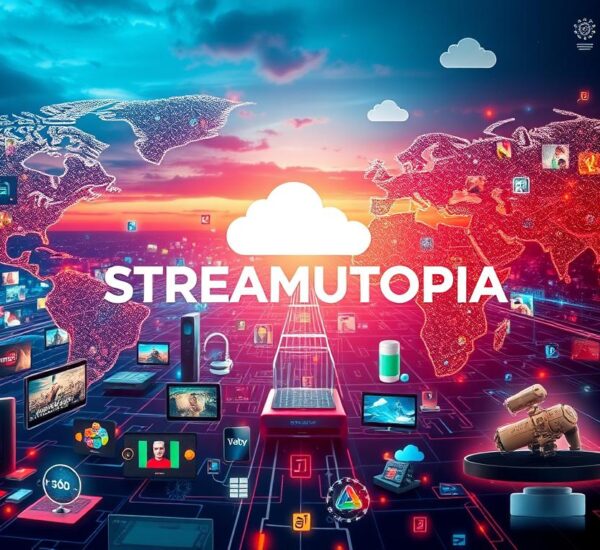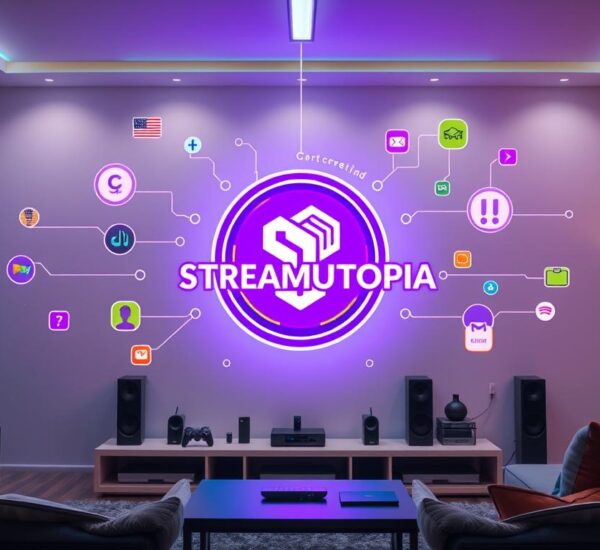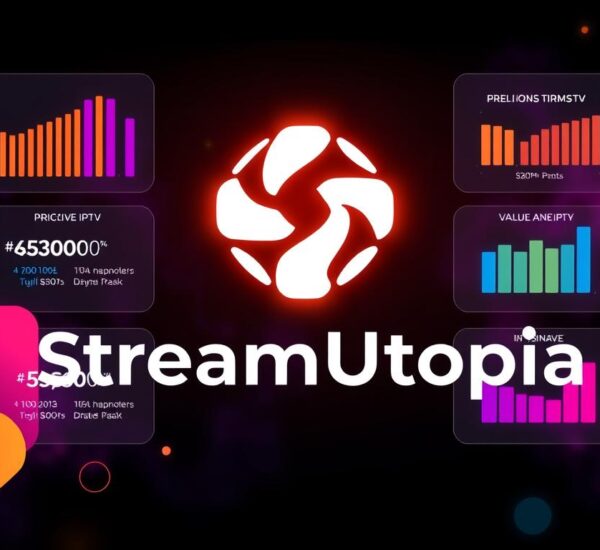Did you know digital rights management (DRM) encryption is key? It secures IPTV users’ premium content. It stops unauthorized access and piracy.
DRM encryption keeps video content safe. It’s sent and stored in an encrypted way. This means only the right users and devices can see it. Before streaming, the content is encrypted. A decryption key is needed from a licensed server. This key is then used to unlock and watch the content.
DRM tech adds a strong level of protection for IPTV content. With DRM, content creators can control copying, device access, and sharing. This helps protect their work and their rights.
Key Takeaways:
- DRM encryption is crucial for securing IPTV users’ premium content.
- It allows only the authorized devices and users to view the content.
- DRM encryption protects copyrighted work from piracy.
- Content creators can manage copying, device access, and sharing thanks to DRM.
- DRM ensures IPTV content’s integrity and security. It guards the investments of those who create and share the content.
How DRM Protects Content from Unauthorized Access
DRM keeps IPTV content safe from those who shouldn’t see it. Before videos get streamed, they go through DRM encryption. This makes the content work on many devices. It also stops people from watching or sharing it without permission. To watch, the video player needs a special key from a trusted server. Only when the right person and device are checked, the key is given. This step makes sure only authorized eyes watch the content, keeping it safe.
DRM combines encryption and access checks to lock content away. This makes sure only legit viewers with approved devices get to watch. Such a tight security prevents stealing and sharing content illegally. It makes the IPTV experience safer for all who should be enjoying it.
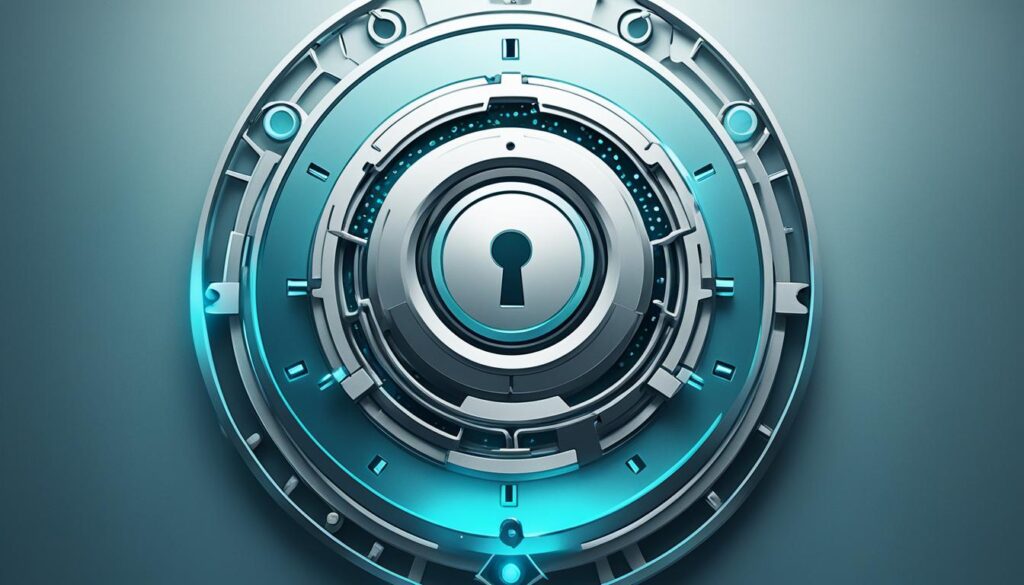
The Role of DRM Encryption
DRM encryption turns video content into secret code. This hides the content from those without the right key. So, the video stays safe whether it’s being watched or saved, stopping curious eyes.
Access Control for Authorized Users and Devices
In DRM, access control is key to keeping content safe. It checks if the viewer and device are allowed before showing the content. This way, only those with permission get to watch, protecting the content’s creators and their work.
| Key DRM Features | Benefits |
|---|---|
| Content Encryption | Protects content from unauthorized access and distribution |
| Access Control | Ensures that only authorized users and devices can access the content |
| Protection Against Piracy | Prevents unauthorized viewing and distribution of copyrighted material |
| Secure Content Storage | Ensures that content remains encrypted and protected during storage |
DRM encryption and access checks make a strong shield for content. This protects the work of its makers and makes sure only the right people see it. IPTV platforms ensure their content is for their true fans only, creating a safe and trusted zone for watching.
The Importance of DRM in the Media and Entertainment Industry
The media and entertainment field uses DRM protection to fight piracy. This helps keep content creators’ work safe from being copied or used without permission. DRM secures music, movies, and more, saving content makers from losing money.
Today, it’s easier to share files online, which poses a piracy risk. Peer-to-peer sharing and online hubs give anyone access to copyrighted material. DRM is crucial to keep this content safe and only available to those who have permission to use it.
DRM also lets creators decide how their work is used. They can set limits on copying and sharing, which helps them make money off their content. This way, they can ensure their creations maintain their true worth.
As the industry switches more to digital and streaming, DRM becomes even more important. Strong DRM keeps content safe and ensures that those who create it get the deserved profit. It also keeps the digital market fair for everyone.
The Impact of Content Piracy and Copyright Infringement
Piracy and copyright violations harm the industry by devaluing creativity. They reduce financial gain for original content creators and can lead to job losses. This is bad for the economy of the creative sector.
Using pirated material often means a lower-quality experience for viewers. Legitimate platforms offer better quality and features. So, pirated content undermines trust and satisfaction.
Illegal downloads also bring cybersecurity risks. These may include malware and data theft. DRM helps prevent these issues, keeping viewers and content safe.
| Challenges Faced | Impact |
|---|---|
| Financial losses due to decreased revenue | Decreased investments in new content and talent |
| Undermined value of copyrighted content | Reduced incentive for innovation and creativity |
| Compromised user experience on illegitimate platforms | Decreased viewer satisfaction and loyalty |
| Cybersecurity risks and data breaches | User privacy and security vulnerabilities |
Protecting Content with DRM Encryption
DRM encryption fights piracy by making content hard to steal. It protects media by making it unviewable without the right key.
This technology turns media into a form that’s unreadable without decryption. It helps creators make sure only the right people can access their work.
DRM also lets creators set access limits. They can control how content gets viewed or shared. This protects their rights and content’s value.
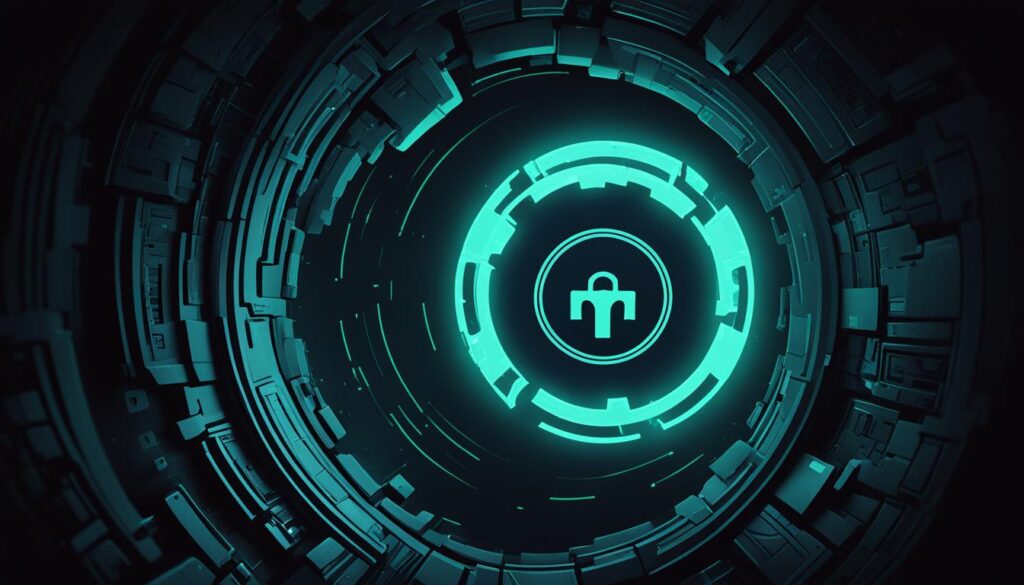
Cybersecurity Challenges
DRM tackles digital challenges like piracy, infringement, and cyber threats. It keeps content makers and their users safe from these risks.
- Content Piracy: Unauthorized access and distribution of copyrighted material through digital channels.
- Copyright Infringement: Unauthorized use of copyrighted content without the permission of the owner.
- Data Breaches and Hacking: Cyber attacks on platforms that store sensitive user information, such as personal details and payment information.
- Malware and Phishing Attacks: Distribution of malicious software and fraudulent attempts to obtain valuable user data.
- Unauthorized Access: Illegitimate access to premium content without proper authorization or subscription.
DRM encryption is a crucial tool to protect against these cyber threats. It helps maintain a safe environment for content and users alike.
The Evolution of Content Protection in Pay-TV
Pay-TV used to rely on smart cards for security. Then Over-the-Top (OTT) and Internet Protocol Television (IPTV) arrived. These brought new threats to content security.
OTT and IPTV let set-top boxes talk back. This meant they needed better security than smart cards alone. Digital Rights Management (DRM) stepped in to offer stronger protection.
DRM uses tech like encryption to keep content safe online. It offers better protection than smart cards did. So, your favorite shows stay secure no matter how you watch them.
The Role of DRM Platforms in Content Security
DRM is key for keeping Pay-TV content safe. It makes sure only the right people can watch. This helps protect the shows and movies we love from theft.
Even how the content is watched is kept safe. DRM prevents thieves from watching your shows for free. It does this by making the content hard to steal.
The Advantages of DRM Platforms
DRM works well in all kinds of TV, from IPTV to OTT. As these methods of watching TV grow, so does DRM. It gets better at stopping piracy and keeping out bad actors.
Table: Comparison of Conditional Access Systems (CAS) and DRM Platforms
| Features | Conditional Access Systems (CAS) | DRM Platforms |
|---|---|---|
| Access Control | Basic | Advanced |
| Security | Reliable | Robust |
| Scalability | Limited | Highly scalable |
| Hardware Support | Specific devices | Wide range of devices |
DRM is top-notch at keeping content safe. It only lets the right people in. This makes it tough for pirates to steal shows and movies.
DRM also works with many devices and TVs. This makes it easy for everyone to watch. And it’s part of why DRM is a big win for keeping content safe and shared.
The Future of Content Protection
DRM will keep growing as Pay-TV changes. It’s ready for new tech like 5G and VR. This means your shows and movies will stay secure, no matter what.
DRM is already a big help in stopping piracy. Everyone, from the people who make shows to the ones who show them, wins. DRM lets them feel safe sharing their best content.
With DRM leading the way, the future of Pay-TV is bright. It helps protect shows and movies, making your watching experience better. DRM keeps the industry safe and strong in a changing world.
DRM as a Key Component of Free Ad-Supported Television (FAST)
In Free Ad-Supported Television (FAST), content is key to grabbing viewers and boosting ad earnings. The need for exciting and varied content is huge. It makes viewers stay with the channel longer and earn more ad dollars. FAST channels stand out by offering unique shows. This makes them more popular and helps them compete well.
Watching shows on FAST also gives platforms useful info to use for ads. They learn about what people like to watch. This lets them show ads that fit viewers’ interests better. It not only boosts ad success but also raises the money they can make.
But, keeping the content safe is a big deal for FAST to work well. DRM is vital for protecting shows from being stolen or seen without permission. With DRM, channels can keep viewers’ info safe. They can also check the quality of their shows. This helps content makers and sellers feel their work is safe.

Benefits of DRM in FAST:
- Enhanced Viewer Trust: DRM makes viewers worry less about their personal info and shows they like being safe.
- Quality Control: It stops people from watching illegal or changed shows, keeping watchers happy with what they see.
- Content Availability: DRM means shows won’t get messed with or shown to the wrong people, so viewers can always watch what they want.
- Protection for Content Producers: It takes care of content makers’ money and makes sure only those allowed can show the shows.
By using strong DRM, FAST channels can look forward to a safe future. They protect their precious shows and make viewers enjoy watching even more.
| Benefits of DRM in the FAST Environment | Description |
|---|---|
| Enhanced Viewer Trust | Viewers feel confident that their personal data and viewing habits are secure. |
| Quality Control | Pirated or tampered content is prevented, ensuring a consistent user experience. |
| Content Availability | Uninterrupted access to content, minimizing unauthorized outages or disruptions. |
| Protection for Content Producers | Safeguarding the investments of content producers and enforcing distribution agreements. |
Content Security Measures for FAST Channels
Fast channel platforms face a big issue in keeping their content safe. They need to protect it from being accessed illegally or pirated. To combat these problems, it’s vital to put in place strong content security measures. Here are the main ways to bolster content security on FAST channels:
DRM Technologies
DRM (Digital Rights Management) is key to protecting content on FAST channels. It uses encryption to make sure only the right viewers can watch the content. This stops the unauthorized sharing and pirating of videos.
Content Watermarking
Adding watermarks to videos is a good way to prevent piracy. Watermarks are unique marks that show a video is the property of someone. They make it easier to trace if the video gets shared without permission.
Content Licensing Agreements
Getting the right content licenses from creators and copyright owners is vital. These agreements give you the legal right to use the content. This helps stop illegal access, use, and sharing of copyrighted works.
Regular Content Audits
Doing content audits often is crucial. They help find and remove content that doesn’t belong there. This keeps the channel’s content clean and ensures it’s all authorized.
User Reporting Mechanisms
Setting up a way for users to report bad or stolen content is important. This lets people help keep the platform secure. It means problems can be addressed quickly, keeping the content safe and legal.
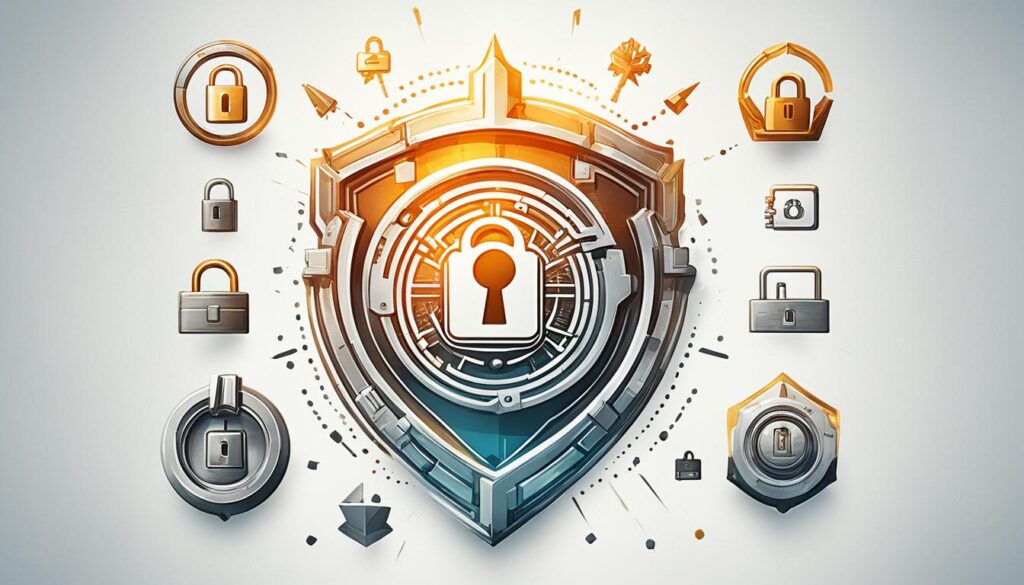
Using all these steps together can make FAST channels safer from piracy and illegal access. With DRM, watermarks, proper licenses, content audits, and user reporting, channels can protect their content. This helps keep the platform trusted and secure for everyone who uses it.
The Growing Role of DRM in Pay TV
DRM technology is expanding into more parts of Pay TV. It was first used to secure VOD content. Now, it’s also used for IPTV, OTT live, and VOD content.
As DRM technology has grown, it’s as good as Conditional Access Systems (CAS) for protecting content. With more use of IP networks and multi-screen OTT, DRM is needed more for security.
DRM offers quick and cost-effective security solutions. It can be used on-premises or in the cloud. As technology in the industry combines, DRM will be key in keeping content safe on all devices.
DRM Expansion in Pay TV
DRM is now used for more than just VOD. It protects content across many Pay TV services, like IPTV and OTT. This lets content providers keep their valuable content safe, no matter how it’s delivered.
Pay TV companies use DRM to make sure only the right people see their content. This stops piracy and illegal sharing. It helps protect the profits of those creating and distributing the content.
Multi-Screen OTT and DRM
Multi-screen OTT services have changed how we watch TV. Now, we can watch on smartphones, tablets, and smart TVs. This has raised the need for secure, easy content delivery.
DRM is crucial for safe multi-screen OTT. It helps ensure only allowed users see the content. This improves the viewing experience and stops illegal access and sharing.
Converged Technologies and DRM
The Pay TV world is moving towards one combined platform. This combines IPTV, OTT, and DVB-H/C technologies. DRM is essential in this new setup for security.
DRM keeps content safe in these new systems. It works for live streams, VOD, or over-the-air shows. This keeps the content secure and only for those allowed to see it.
As these new technologies spread, DRM will become even more important in Pay TV. It helps content providers keep their content safe. Users can enjoy a secure and smooth experience.
Benefits of DRM in Protecting User Data
DRM makes sure not just content but also user data stays safe. This is important because customers need their info and what they watch to be private. Strong DRM systems help the media industry keep its customers’ privacy and data secure.
DRM is great for making sure the content is top quality. It stops people from getting in without permission, changing content, or sharing it illegally. This way, the creators and distributors can keep the value and uniqueness of their work.
DRM also means you can always watch what you like without problems. It stops sudden breaks or issues so viewers can enjoy their shows smoothly. This makes viewers happy and more likely to keep using the service.
DRM is also good for those who make and share content. It helps them stick to their deals with other platforms and partners. They can make sure their content goes where it should and how it should, which is vital for making money.
Furthermore, DRM fights against piracy. It makes it harder for people to steal or share content illegally. This protection helps creators keep their money safe and keeps the digital media market fair.
Overall, using DRM does a lot. It helps with trust, keeps data secure, makes content better, ensures it’s always available, and helps creators make more money. It’s a big win for everyone in the media and entertainment world.
DRM Benefits
| Benefits | Description |
|---|---|
| 1. Subscriber Trust | Builds confidence and loyalty by protecting user data and privacy. |
| 2. Data Security | Safeguards personal information and viewing habits from unauthorized access. |
| 3. Quality Control | Maintains the integrity of digital assets, preventing tampering and piracy. |
| 4. Content Availability | Ensures consistent access to content, minimizing outages or disruptions. |
| 5. Content Producers | Protects investments and enforces content distribution agreements. |
| 6. Content Piracy | Reduces financial losses by deterring unauthorized access and distribution. |
Ensuring a Secure Future for FAST Channels
Fast channels are key players in online streaming, drawing in viewers and making money from ads. To keep their success and protect what they show, strong digital rights management (DRM) is needed. This includes content encryption, watermarking, licensing agreements, audits, user reporting, and sometimes taking legal action. These steps work together to keep FAST channels safe and sound.
Content Encryption
Content encryption is a basic part of DRM. It keeps content safe from those who shouldn’t see it. Only those with special keys can open the encrypted content. This stops piracy and protects the content’s uniqueness.
Watermarking
Watermarking is also great for stopping piracy. It adds marks to your content, showing it’s yours. This makes people think twice before sharing it without permission.
Licensing Agreements
Having licensing agreements is important for content creators. These contracts control how the content is used and shared. It gives creators the power to keep their stuff safe.
Audits
Content audits help keep FAST channels clean. They find and remove any bad or copied material. Doing these checks often can keep the channels on the right side of the law.
User Reporting
Letting viewers report bad stuff is pretty smart. It helps find copyright issues or suspicious things. Then FAST channels can fix the problem quickly.
Legal Action
Sometimes, FAST channels have to take legal action. This is for serious copyright issues. It shows everyone that they mean business about protecting their content.
With these steps, FAST channels can keep their future safe. Using DRM tech like encryption, watermarking, and legal moves, they protect their content and the way they make money. This ensures viewers have a great, safe time watching their favorite shows and videos.
Conclusion
In the world of IPTV, keeping content safe is very important. Digital rights management (DRM) is key to this. It keeps IPTV content safe from being copied illegally.
DRM uses encryption to protect content. It makes sure only the right people can watch it. This helps content creators keep their work safe and secure the content’s future.
Technology is always getting better. As IPTV and OTT services get more popular, DRM’s job grows. It helps keep the content protected, giving users a better watching experience.
DRM is a big help in the fight against piracy, working with creators and distributors. It aims to keep the industry strong. By keeping up with new DRM tools, the entertainment world can keep making IPTV better and safer for everyone.
In summary, DRM is crucial for IPTV content safety. Its use in IPTV platforms helps fight piracy. It makes sure good content is protected. This way, viewers can enjoy their favorite shows safely. As the field advances, DRM will keep making IPTV a secure and enjoyable space.
FAQ
What is IPTV?
What is DRM encryption?
How does DRM protect IPTV content from unauthorized access?
What is the importance of DRM in the media and entertainment industry?
How has content protection evolved in the Pay-TV industry?
What is the role of DRM in Free Ad-Supported Television (FAST) channels?
What content security measures can be implemented for FAST channels?
How does DRM play a role in the growing Pay TV industry?
What are the benefits of DRM in protecting user data?
How can FAST channels ensure a secure future?



